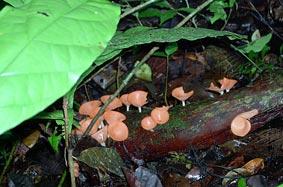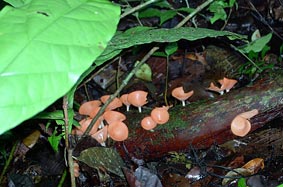Death and resurrection

Not only delicious with a bit of bacon, fungi provide an invaluable service in the cycle of life, says Éanna Ní Lamhna
After the storms of last week, the countryside is beginning to look tattered. Now that we have passed the equinox, there is no longer any denying that autumn is well and truly here. The best things about autumn are the smells that emanate from wet hedges and piles of leaves on the ground, tangible evidence that an invisible form of life is stirring. And indeed it won't be long until we are able to see what is producing this wonderful plethora of smells – fungi, the recyclers par excellence!
Rotting and decaying is a living process carried out by bacteria and fungi. These lifeforms do not make their own food as plants do, but derive sustenance from dead plants and animals. They play a vital role in our world. Can you imagine what the world would be like if nothing rotted away? We'd be up to our oxters in dead leaves in no time. The dead tree in the photo is being re-absorbed by the fungus, which is fruiting so prettily all over it. The carbon atoms of which the tree is composed are being recycled back into the atmosphere via the invading fungus.
But not only do fungi serve this useful necessary purpose – for the most part silently and invisibly absorbing the dead material through their strand-like white mycelium in the soil – but when they send up visible, and often smelly, fruiting bodies in the autumn, they can become a delicious item of food. In the days before slurry-spreading and sileage-making, people combed the fields in September collecting white button mushrooms for a tasty breakfast. Braver souls recognised the white puff balls in the hedges (known in some parts as sheep's farts) and enjoyed them fried in slices in the bacon fat left in the pan after frying the rashers.
We spend a king's ransom in upmarket shops buying small amounts of dried mushrooms, but the same fungi are available for free if you know where to look – and if you are sure of their identification. We are very bad at recognising edible wild mushrooms – not like our middle European colleagues who enjoy such autumn luxuries. But we are right to be wary if we are not sure – there are several mushroom species in this country that can kill us stone dead if we eat them and they look quite like ones that are edible.
Perhaps as our country becomes more multi-cultural we will become more familiar with this autumnal largesse – nature's compensation for the darker days and the blustery weather. But if you do indulge in unfamiliar mushrooms, don't eat them all. Leave one or two on the mantelpiece for the state pathologist, to save her having to open your stomach in the event of your sudden demise.
